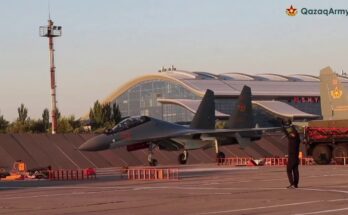With its latest budgetary earmark announced on February 1, India’s defense establishment can expect another year of limited military modernization.
The FY25-26 allocation is set at INR6.81 trillion ($77.8 billion), or 1.9 percent of GDP. This represents a 6.2 percent nominal rise over the FY24-25 revised budgetary allocation (the initial budgetary announcement is the Budget Estimate, with a Revised Estimate following later in the fiscal year representing the final earmark).
However, when funding for pensions is stripped from the total this topline figure drops to INR5.21 trillion ($59.5 billion) and around 1.4 percent of GDP. The year-on-year increase shrinks accordingly, down to 3.83 percent – all before inflation is factored.
With the Reserve Bank of India estimating inflation of 4.2 percent for the coming fiscal year, the overall picture for the FY25-26 defense budget darkens.
For India’s armed forces, a budget incapable of keeping ahead of inflation – with defense inflation generally higher than core consumer inflation – presents a significant concern as the military is tasked with countering a potential collusive threat from New Delhi’s neighboring strategic rivals, China and Pakistan.
This becomes even more worrisome for India once China’s ongoing military buildup – and its support for India’s archrival Pakistan – is considered. With an official defense budget of roughly $233 billion for last year (and an unofficial one estimated far higher than $300 billion), China already invests three times what India will be spending this year towards its armed forces.
Perhaps most worrisome in the latest defense budget estimates is that the greatest increase in any fiscal category falls under the pension envelope, which accounts for 24 percent of the overall total. While a boon for retired Indian officers and soldiers, this does nothing to improve the overall effectiveness of the Indian armed forces.
Capital expenditure – referred to as the Capital Head or capital outlay – will increase by just 4.65 percent year-on-year under the latest budget estimate, topping out at INR1.8 trillion ($20.56 billion). This portion of the budget represents funding earmarked for procuring major equipment platforms and military hardware, research-and-development, as well as the creation of infrastructure (such as roads, airstrips, barracks, depots, and naval bases), which may (or may not) also include the acquisition of land/property to build on or across.
While the $20 billion earmarked for capital expenditure appears significant on paper, upon scrutiny the scope of the funding is less substantial. The portion of this total allocated for procurement is largely used to pay off legacy contracts rather than to fulfill new, pressing materiel requirements (up to 80 percent of the Capital Head budget is generally assigned to cover costs for “committed liabilities,” or programs underway or already completed).
Most noticeably, the Indian MoD has stated that of the INR1.1 trillion ($12.7 billion) of the Capital Head budget earmarked for modernization, 75 percent – or INR825 billion ($9.5 billion) – will be invested in solutions from domestic sources, while the remaining 25 percent will be used on purchasing from local private sector companies.
In other words, the entire modernization spend will go towards indigenization as part of Prime Minister Narendra Modi’s ongoing “Atmanirbhar Bharat Abhiyan” (Self Reliant India Campaign) initiative.
The initiative builds upon a longstanding Indian goal of weaning its armed forces off foreign-sourced hardware to ensure localized support, the maintenance and supply of equipment, and the recycling of rupees from the defense budget back into the domestic industry.
Yet despite such efforts, India remains the world’s leading defense importer and must rely on advanced systems sourced from abroad.
Worse, India’s labyrinthine procurement system is, at best, uneven and more than not fails to deliver on major acquisitions without undertaking multiple bids. The result is new systems arriving many years – and sometimes well over a decade – after their respective acquisition programs were cleared by the Defence Acquisition Council (DAC).
Thus, the combination of a limited, still-evolving industrial base, a poorly performing acquisition process, and a budget that is often insufficient for the government’s grand modernization ambitions, leaves India with a widening gap between what it aspires to be as a regional power and what its strategic environment presents.
India’s aspiration of becoming a major regional power and global player, having an offensive deterrent versus Pakistan and a defensive deterrent versus China, and fielding a blue-water Navy that projects power across the Indian Ocean Rim, remains in place. But for now, those strategic ambitions continue to outpace resourcing. The latest budget outlay does little to alter that reality.
Dan Darling is Forecast International’s director of military and defense markets. In this role, Dan oversees a team of analysts tasked with covering everything from budgeting to weapons systems to defense electronics and military aerospace. Additionally, for over 17 years Dan has, at various times, authored the International Military Markets reports for Europe, Eurasia, the Middle East and the Asia-Pacific region.
Dan's work has been cited in Defense News, Real Clear Defense, Asian Military Review, Al Jazeera, and Financial Express, among others, and he has also contributed commentary to The Diplomat, The National Interest and World Politics Review. He has been quoted in Arabian Business, the Financial Times, Flight International, The New York Times, Bloomberg and National Defense Magazine.
In addition, Dan has made guest appearances on the online radio show Midrats and on The Media Line, as well as The Red Line Podcast, plus media appearances on France 24 and World Is One News (WION).




